One of the series of 'Pages
on things that TICK ME OFF!'
TIGHAR
- The International Group for Historic Aircraft
Recovery
A
Critical Analysis of a Non-Profit Organization
NEW LOCATION:
https://mffowler.net/tighar_analysis.htm
Overview
TIGHAR - The International Group for Historic Aircraft Recovery -
is a US non-profit group founded
in 1985 by Ric Gillespie and his wife, Pat Thrasher. Gillespie has been TIGHAR's only executive director. A former aircraft insurance industry investigator, Gillespie
has a bachelor's degree in history, and is a licensed private pilot and former US Army
officer, but has no formal training in archaeology,
forensic investigation, anthropology, photo analysis, oceanography, remote
sensing, electronics, genetics, radio wave propagation, meteorology or any of the other myriad of
specialized fields TIGHAR might require.
Which does not, however, stop Gillespie
from making definitive statements on many different subjects.
TIGHAR's Efforts
Over the past 33 years, TIGHAR
has undertaken a number of what it usually calls "projects" or
"operations." All have been failures, to a greater
or lesser degree. Despite its name, TIGHAR has never recovered a single
complete aircraft of any type. It has never recovered a single verified piece of a historic
aircraft. It now states on its website that is not what it is about - yet the name stands.
Each project generally follows the same
format: Latch on to something aviation history-related that has potentially high public interest (and hence
fund-raising/marketing value); give it a catchy name, slick logo, etc.; sell various items
like T-shirts, coffee mugs and certificates with that name on it to give people a sense of ownership and purpose;
attract a few high-dollar sponsors to mount media attention-drawing "expeditions;"
spin it
out until public interest and/or fund-raising potential wanes. Repeat ... repeat
... repeat
again.
A few examples:
Project Midnight Ghost
TIGHAR's first effort started in 1984, before the group was
incorporated as a non-profit. Project
Midnight Ghost aimed to discover what happened to Frenchmen Charles Nungesser and Francois Coli, who took off from an airfield near Paris in May 1927 in
the bid to be the first to cross the Atlantic Ocean from Paris to New York non-stop. They never
made it. A few weeks later, American Charles Lindbergh crossed the Atlantic, landed in Paris and
made aviation history.
Searches turned up no trace of the Frenchmen.
Francois Coli, who took off from an airfield near Paris in May 1927 in
the bid to be the first to cross the Atlantic Ocean from Paris to New York non-stop. They never
made it. A few weeks later, American Charles Lindbergh crossed the Atlantic, landed in Paris and
made aviation history.
Searches turned up no trace of the Frenchmen.
In 1980, a
magazine article
about the flight related folklore from northern Maine about a woodsman hearing an airplane crash in 1927.
After 20 searches in the Maine woods for what Gillespie called "history's
most important missing airplane," accompanied by many "we've
found something significant" announcements which amounted to nothing, in
1992 TIGHAR’s search shifted to Newfoundland,
where different folklore holds that an airplane crashed in a pond.
Although TIGHAR said it has "strong" archival and physical
evidence (after nine expeditions) that indicates an aircraft crashed somewhere
in the area, it has not released specifics. A piece of metal TIGHAR recovered from one of these ponds, which may or may not have been from the French
aircraft, was turned over to local authorities. TIGHAR has since lost track of it.
The cost of the project as a whole is unknown, due to the way TIGHAR filed its
federal tax returns; neither is it known how many thousands of member's dollars
TIGHAR has spent on it to date. Gillespie considers this project active,
although nothing has happened for years.
The Beast of Bombay Hook
In 1992 TIGHAR partially excavated the wreck of a
P-47D Thunderbolt fighter that had crashed after takeoff from what was
then Dover Army Air Corps Base, Delaware, in 1944. Although TIGHAR reportedly provided
documentation of the excavation to Dover Air Force Base officials so the
aircraft could be recovered, nothing further was apparently done and there is nothing
publicly available on the Dover AFB Museum (now the Air Mobility Command Museum)
website about this effort. It is unknown if what was recovered was even retained;
the full cost to TIGHAR members was never released.
The Lady in Waiting
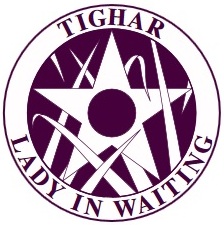
In 1942, a US Army Air Force pilot belly-landed
his B-17E bomber in a New Guinea swamp. TIGHAR called it "without doubt, the most significant unrecovered WWII aircraft known to
exist" (this verbiage becomes a consistent theme of other projects, and,
notably, no other aviation history-related entity generally agrees with
Gillespie). TIGHAR self-labeled the bomber
the "Lady in Waiting," stating that the title "Swamp Ghost"
bestowed on it by other groups was not respectful enough, and surveyed the site in 1986.
Although TIGHAR announced that it would recover and
restore the B-17 in cooperation with several other entities, those efforts
collapsed for reasons never fully made clear; then Papua New Guinea halted all such activities. The B-17 was illegally
recovered by others in 2006, impounded until 2010, and is now being slowly restored at the Pacific Air Museum in
Hawaii, with no help from or involvement by TIGHAR. It is unknown how many
thousands of dollars, membership and otherwise, TIGHAR spent on this effort.
Operation Sepulcher
 Persistent rumors said that at the end of World
War II, German forces dynamited underground hangers full of intact
Luftwaffe aircraft, to hide them from the advancing Allies. A "treasure trove" of
aviation history, Gillespie wondered? TIGHAR investigated
what it called "the most
promising rumors" via archival research and on-site inspections. Despite two decades of
on-again, off-again searching, TIGHAR found nothing. The project was deactivated
in 2008;
final costs have never been released publicly.
Persistent rumors said that at the end of World
War II, German forces dynamited underground hangers full of intact
Luftwaffe aircraft, to hide them from the advancing Allies. A "treasure trove" of
aviation history, Gillespie wondered? TIGHAR investigated
what it called "the most
promising rumors" via archival research and on-site inspections. Despite two decades of
on-again, off-again searching, TIGHAR found nothing. The project was deactivated
in 2008;
final costs have never been released publicly.
The Earhart Project
 By far TIGHAR's most well-known/publicized
and highest-profile effort. Amelia Earhart,
the world-famous aviatrix, and her navigator, Fred Noonan, vanished without a
trace in the Pacific Ocean in 1937 while trying to fly around the world. TIGHAR
entered the decades-old controversy of what happened to them in 1988 with the launching
of the Earhart
Project. TIGHAR has conducted 12 expeditions to date to Nikumaroro, a remote island in the central Pacific Ocean, where Gillespie
hypothesizes that Earhart and Noonan successfully landed and eventually died.
By far TIGHAR's most well-known/publicized
and highest-profile effort. Amelia Earhart,
the world-famous aviatrix, and her navigator, Fred Noonan, vanished without a
trace in the Pacific Ocean in 1937 while trying to fly around the world. TIGHAR
entered the decades-old controversy of what happened to them in 1988 with the launching
of the Earhart
Project. TIGHAR has conducted 12 expeditions to date to Nikumaroro, a remote island in the central Pacific Ocean, where Gillespie
hypothesizes that Earhart and Noonan successfully landed and eventually died.
Nothing
definitive has ever been discovered by TIGHAR, despite numerous announcements that
some item or another found on Nikumaroro solved the mystery. TIGHAR has,
however,
discovered and publicized a great deal of hitherto unknown and valuable information about
Earhart's final flight.
The Earhart Project has not only been TIGHAR's
most well-known effort, it has been its biggest money-maker over the decades. Gillespie once stated that Amelia Earhart was a "faucet of fame"
as far as fund-raising goes, that he could turn on or off as new "research" or
new "artifacts" or new a "analysis" came to light to generate
more publicity and funding for more expeditions to Nikumaroro and other things
Earhart-related.
The faucet was apparently turned off by 2016,
though - pitches to numerous potential funders
failed, and the Nikumaroro IX expedition had to be drastically scaled back and piggybacked onto
an already-scheduled trip hosted by another group. Needless to say,
Gillespie did not collect his originally planned-for six figures in "operating
expenses."
Since 2008 alone, Gillespie has spent more than $4.5 million on trips to Nikumaroro
and in excess of $5 million for the Earhart Project as a whole (cumulative
totals have never been released).
The Devastator Project
 In 1942, two US Navy TBD-1 Devastator
torpedo bombers ditched in the lagoon of Jaluit Atoll in the Pacific Ocean
after being hit by antiaircraft fire during a raid on the Japanese-held
island. TIGHAR calls the TBD one of the most significant aircraft in the history
of naval aviation (sound familiar?), and states that since no example of the
Devastator survives in any museum, recovering one would be an extremely valuable
undertaking to the aviation historical community (sound familiar?). TIGHAR launched a project in 2004 to
survey and/or recover one or both of the wrecks.
In 1942, two US Navy TBD-1 Devastator
torpedo bombers ditched in the lagoon of Jaluit Atoll in the Pacific Ocean
after being hit by antiaircraft fire during a raid on the Japanese-held
island. TIGHAR calls the TBD one of the most significant aircraft in the history
of naval aviation (sound familiar?), and states that since no example of the
Devastator survives in any museum, recovering one would be an extremely valuable
undertaking to the aviation historical community (sound familiar?). TIGHAR launched a project in 2004 to
survey and/or recover one or both of the wrecks.
In 2006, a joint TIGHAR/US Navy expedition
evaluated the aircraft. Despite TIGHAR's statements that the National Museum of Naval
Aviation intended to recover at least one of the Devastators in cooperation with TIGHAR, nothing
happened. The museum is apparently no longer interested in these aircraft, or in
cooperating with TIGHAR, although Gillespie
said
in early 2016, "If there are no recent updates you can safely assume that,
for the good of the project, we're not at liberty to provide an update." Which
makes no sense, and conflicts with what the NMNA has said. TIGHAR has spent at
least $207,000 on this project to date; complete costs and member's dollars
expended have never been released.
TIGHAR stopped actively soliciting funds for this
project in 2016, after a TIGHAR member raised concerns about the ethics of collecting
money for something that in all likelihood would never happen, considering that
11 years had passed.
The Maid of Harlech
In 2007, a Lockheed P-38 Lightning fighter
aircraft was exposed on a beach in Wales, Great Britain, where it had crash
landed in 1942. TIGHAR christened it the Maid of Harlech, after a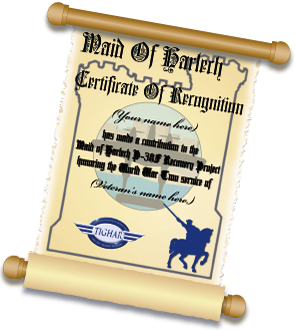 nearby castle,
and calls it one of the most significant WWII-related archaeological
discoveries in recent history: "Recognizing the Lightning’s historical significance
as the oldest surviving Eighth Air Force combat veteran, and its potential as an
object of study in corrosion research, TIGHAR has made a commitment to champion
the aircraft’s recovery and preservation." Again, does this verbiage sound familiar?
And, again, no other aviation-related entity has made a
similar determination.
nearby castle,
and calls it one of the most significant WWII-related archaeological
discoveries in recent history: "Recognizing the Lightning’s historical significance
as the oldest surviving Eighth Air Force combat veteran, and its potential as an
object of study in corrosion research, TIGHAR has made a commitment to champion
the aircraft’s recovery and preservation." Again, does this verbiage sound familiar?
And, again, no other aviation-related entity has made a
similar determination.
After surveying the wreck, TIGHAR declared its exact location must remain confidential to
prevent looting (even though at times it is clearly visible on Google Earth).
Although a British TIGHAR member at one point had a government license to
recover the aircraft, that has apparently lapsed. A local government entity
allocated funds to do some basic conservation activities; TIGHAR has
nothing to do with that. As of 2017, there is no projected date for any
further activities on the wreck. Exactly how much of member's money TIGHAR has spent is unknown;
project costs exceed $6,000 but the exact total is unknown.
TIGHAR stopped actively soliciting funds for this
project in 2016, after a TIGHAR member publicly raised concerns about the ethics of collecting
money for something that in all likelihood would never happen. Donations are
still being accepted through TIGHAR's on-line store, but the link is for a
general donation.
To reiterate - every one of these
projects has been a failure, to a greater or lesser degree.
Specific information on how much money TIGHAR has spent on its
many
projects is lacking in anything but the broadest of terms
- Gillespie seldom releases specific cost breakdowns. There is
little transparency regarding the more than $6.34 million spent on projects
since 2001 and, hence, no real accountability, both of which are contrary to
widely-accepted best
practices for running a non-profit.
"Scientific" Research Methods?
Gillespie constantly touts the fact that TIGHAR adheres
to "the scientific method" and rigorous analytic and research
protocols. True - up to a very limited point. Look at individual
examples, however, and it becomes clear that "research" sometimes stops on a
particular item or theory when it ceases to support Gillespie's position, or when
it can no longer be used as part of a fundraising pitch or to
garner media attention. A few examples:
The Radio Calls
Gillespie says one of the cornerstones of TIGHAR's Earhart
hypothesis is the radio calls - transmissions allegedly made by Earhart for a number
of nights after she and
Noonan disappeared. One reason TIGHAR flatly dismisses the "crashed and
sank at sea" Earhart theory is because if even one of the
post-loss radio calls is genuine, Earhart managed to land her Lockheed Electra
aircraft somewhere.
The problem with this blanket assertion is that no one outside of TIGHAR
has done an independent analysis of the probability of its being true.
While TIGHAR has issued voluminous "research
bulletins"
looking at every single alleged transmission, when people with knowledge about
1930s radio and radio wave propagation started asking detailed questions on the TIGHAR
internet discussion forum, the TIGHAR
member who did the bulk of the analysis retreated into silence. Gillespie has
stated that anyone else is free to analyze the information, and that all of
TIGHAR's data is available. True enough - but only with regards to
TIGHAR's self-aggregated data. More troubling, other Earhart Project information on TIGHAR's website seems to contradict the radio calls scenario, and no
attempt is made to reconcile or explain this.
What Gillespie has steadfastly declined to do is submit the
"research"
to independent experts on TIGHAR's behalf, for a second opinion in order to
validate it. Nor has he
detailed the exact criteria TIGHAR used to determine which of the alleged
transmission were either "credible" or "not credible," or made TIGHAR's expert
available to other independent evaluators to assist in the review. All of which
flies in the face of the scientific method and calls into question the validity of TIGHAR's conclusions,
at least
for any trained scientist.
Not
explaining how you determine whether something is credible deprives anyone else of
making an independent test of the same information, using your criteria, to see
if they get the same result. Replicability is one of the hallmarks of scientific
research - and Gillespie, for whatever reason, does not want to go there.
The Wreck Photo
In 1989 Gillespie was shown a grainy
black-and-white photo of a twin-engined aircraft crashed in a jungle setting and
asked in a TIGHAR newsletter article,
Is This Earhart's Electra? He investigated the photo off and on for the next
20 years, while issuing
numerous "research bulletins" and updates about how the wreck could, or could
not, be Earhart's aircraft. In 1998 Gillespie stated the photo could
not be of a Japanese Tachikawa Ki-54, a twin-engined
aircraft which looks similar to the Electra, after reviewing captured
Japanese aircraft plans at the Smithsonian Air and Space Museum.
The subject sparked regular debates on
TIGHAR's discussion forums and was frequently discussed as possible proof of TIGHAR's Earhart hypothesis, until 2006,
when Gillespie said, "After many years of research and head-scratching, I'm
convinced that the Wreck Photo shows a Tachikawa KI-54 'Hickory' advanced
trainer. My belief is based upon the visible structural components and
especially upon the presence of a small circular inspection plate on the nose."
However, it took Gillespie another
three years, until 2009, to come out with a "research bulletin" titled
The
Wreck Photo Resolved, which laid out his evidence for discounting the photo as
being of Earhart's Electra. TIGHAR members were never given an explanation for
the lengthy delay in issuing the final bulletin (although at least a final
bulletin was issued in this case). No other aviation-related
entity has independently evaluated TIGHAR's claims dismissing the wreck photo.
Other "Research" Concerns
● One side
issue in all of this is what exactly
"research" is, and is TIGHAR calling it research when it really isn't?
The US government broadly defines research as the accumulation of knowledge.
Fair enough. But is repackaging what is already known and freely available
to all "research?" Gillespie thinks so. One recent example is
his "research bulletin" on The Long Farewell of the Norwich City,
a compilation of photos showing the gradual disintegration of a ship that ran
aground at Nikumaroro in 1929. The photos are available on the
internet. Is stringing them together in one web document a
"research bulletin," or simply a way to make something look and sound like more than
what it really is? Would it be more accurate to call these "promotional pieces"
for TIGHAR's theory?
of the Norwich City,
a compilation of photos showing the gradual disintegration of a ship that ran
aground at Nikumaroro in 1929. The photos are available on the
internet. Is stringing them together in one web document a
"research bulletin," or simply a way to make something look and sound like more than
what it really is? Would it be more accurate to call these "promotional pieces"
for TIGHAR's theory?
● Despite Gillespie's insistence that TIGHAR employs
scientific methods, and his dismissal of "guesses masquerading as facts," he has repeatedly rebuffed suggestions that TIGHAR
needs an overall research plan, a common scientific
practice that prioritizes what to expend time and effort on, in order to maximize use of scarce resources. Gillespie
seems to prefer to "research" whatever bright shiny thing may be used for
fundraising or to spark media interest at any particular time. A few examples:
The Patch, the Knob that Wasn't, the Nikumaroro photos found in New Zealand,
etc., information on all of which is on TIGHAR's website.
●
Gillespie has a
consistent, at times unswerving, tendency to attribute almost any artifact found on Nikumaroro to Earhart and Noonan unless
exhaustive research proves otherwise. Which he is not always willing to do.
● Promised final "research bulletins"/reports on a
number of important Earhart topics and/or artifacts have never been
completed, which among other things calls into question TIGHAR's tax-exempt
status as an educational entity. If it is not completing things that
might legitimately be considered educational activities, what
is Gillespie spending all his time doing? Just a few examples: The forensic analysis of
Betty's Notebook, the final report on the 1937 New Zealand photos of Nikumaroro, the report on how rivet lines were discerned on photos of The
Patch (a potentially crucial artifact), many of the other small
artifacts found on Nikumaroro, the "putative poop," etc. (Details on
all of these are on TIGHAR's website as of this writing).
● To
TIGHAR's credit, outside reports that contradict Gillespie's Earhart
hypothesis are included on TIGHAR's website, but they are not highlighted
in any way - they are simply buried amidst the huge amount (85 as of this
writing) of other Earhart Project "research
bulletins."
●
Very disturbing is Gillespie's lack of
comment on what will eventually happen to the large amount of
valuable Earhart material that TIGHAR has amassed; indications are that he does not
care. A genuine researcher or scientist would take steps to ensure that the
materials were available to future researchers for generations to come. It
would be reasonable to expect details of such a plan on TIGHAR's website.
The lack of which,
again, seems to indicate that the Earhart mystery has little more than monetary
value to Gillespie.
● Gillespie has consistently relied on a
handful of
people he considers experts over the decades to support his
contentions. A major
qualification seems to be that they are willing to work for free.
Which is fine, it saves TIGHAR money from having to hire experts, but it is
not fine in that Gillespie has not always released
precise details of these expert's methods, equipment, computer analysis software used,
how they made the assumptions they used for various analyses,
etc. When you don't know exactly how someone did something, you can't try to do the
same thing yourself to see if you get the same result. Replicability is
a cornerstone of how real scientists do things. That is not always how TIGHAR has
operated.
● When the promotion becomes the research, that's
another problem at odds with the scientific method.
One example is the Miami airport photos and going to Miami when a phone call would have
sufficed. In 2014, a TIGHAR member paid an independent researcher to scour the
Pan American Airways archives in Miami in hopes of finding more information
about repairs to Earhart's Electra before its
final flight. The researcher found a number of previously unknown photos of the
aircraft, including several that highlighted The Patch, a repair to the plane
that TIGHAR believes it has found a piece of on Nikumaroro. Gillespie announced
that he and a forensic photo analyst would fly to
Miami to personally investigate this potentially game-changing piece of
evidence. Except - the trip wasn't necessary. The photo turned out to be a scan
of an original print, of insufficient resolution to be helpful. The
Miami archivists could have told Gillespie it was a scan with a simple phone
call. So why were the trip and the fanfare even necessary? No final report on
The Patch has been issued by TIGHAR.
● And finally, no TIGHAR "research bulletin" or
"paper" has ever been subjected to any kind of peer review or outside independent review
by people qualified to do so to date (December 2017),
which Gillespie has publicly stated is a blessing, because it keeps TIGHAR from
getting bogged down in what he calls "an academia mindset". People are expected to accept
everything in TIGHAR's voluminous materials as true and correct, simply because Gillespie says it is.
Broken Promises
Although there are several TIGHAR actions that
fall into the "broken promises" category, two recent incidents stand
out.
In February 2015, Gillespie announced that a video of the Nikumaroro
VIII Earhart Expedition would be produced, and, in a first for TIGHAR, would be done
in-house so
 TIGHAR could keep all of the profits from media
rights. Fair enough. Anyone who donated at least $49 to the production through
the Your Name Up In Lights campaign would receive a credit at the video's end as
a way of thanks. An unknown number of people donated (TIGHAR never released
specifics). All well and good.
TIGHAR could keep all of the profits from media
rights. Fair enough. Anyone who donated at least $49 to the production through
the Your Name Up In Lights campaign would receive a credit at the video's end as
a way of thanks. An unknown number of people donated (TIGHAR never released
specifics). All well and good.
Except the video never happened, and other than
saying in January 2016 it is "indefinitely delayed," Gillespie refuses to discuss it.
Taking money from someone to do something, and
then not doing it is, at the very least, unethical by anyone's definition. TIGHAR may, at some point, deliver a video of some kind that has
something to do with Nikumaroro VIII, but until then, almost everyone who
pledged is simply out that money with no guarantee of when, or if, they will get anything in return.
Gillespie's shutting down
all discussion on the topic
deprives members of the option to ask for their money back, because no one knows if he will do so. One could argue that no theft has been
committed, nor any deception, since "something" may be provided at
some point, but the facts remains - TIGHAR made a promise,
hasn't delivered, has no schedule to deliver and is keeping the money in the meantime.
A second recent instance of trying to keep the money - and
then changing what was promised - is the Literary Guild II and the book that never was.
In 2006 Gillespie wrote and the Naval Institute Press published Finding
Amelia, The True Story of the Earhart Disappearance. It laid out in great
detail what Gillespie calls his "preponderance of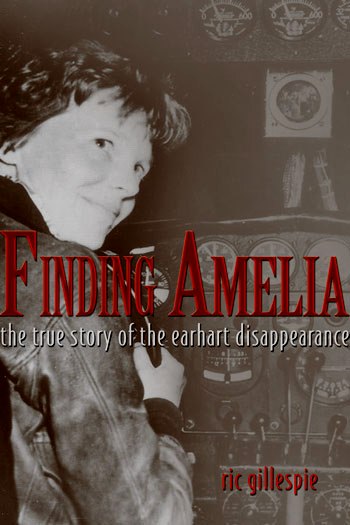 evidence" for
how Earhart and Noonan ended up on Nikumaroro. It was partly funded by TIGHAR members through
the so-called Literary Guild. For a donation of at least $100, contributors would
get a signed copy of the book when it was published. Ninety-three
members joined the Literary Guild, and Finding
Amelia was published.
evidence" for
how Earhart and Noonan ended up on Nikumaroro. It was partly funded by TIGHAR members through
the so-called Literary Guild. For a donation of at least $100, contributors would
get a signed copy of the book when it was published. Ninety-three
members joined the Literary Guild, and Finding
Amelia was published.
Several years later Gillespie announced the
follow-on book, Finding Amelia II, to detail developments since the
first book. As with Finding Amelia, this book
prompted the formation of the Literary Guild II to solicit $100 donations,
under the theory that Gillespie could not write and fundraise for operating
expenses at the same time.
Except the book never happened. In
mid-2015, Gillespie said since there was so much new information
developing in so many areas, the book would, instead, become an exhaustive
examination of
Earhart's Lockheed Electra 10-E Special aircraft. No one who pledged money to the Literary
Guild II was asked if they were OK with this radical change
in plans.
When a longstanding TIGHAR member did
object on the TIGHAR discussion forums, Gillespie at first attempted
to shut that person down with denigrating comments. When that didn't work, he
tried ignoring the increasingly pointed protests that a book about the aircraft
wasn't what had been promised and wasn't what people had pledged money towards.
Only when it looked like a public relations disaster was imminent did Gillespie
admit that upset TIGHAR members might have a point.
So, unlike with the
broken promise of the Nikumaroro VIII video, donors were given a choice: They could
wait for the Finding Amelia II book at some unspecified point in the future, accept the "new" book
about the Electra instead, or get their money back. An unknown number of members asked
for their money back - Gillespie never released specifics.
He has also admitted that pledges for the
Literary Guild II for the Electra book have
tapered off. Progress on that book seems to have all but stopped; there
was not even a tentative publication date listed on TIGHAR's website as of late 2017,
although earlier that year Gillespie said he wanted to get it published by
Christmas - if he could raise the $50,000 or so he said he needed to finish the writing.
No recent information has been released on that fundraising campaign, either.
The original Finding Amelia II book is not even being discussed.
Lifestyle Support?
Dorothy Cochrane, aircraft curator at the
Smithsonian’s National Air and Space Museum, who has long disagreed with
Gillespie, puts it succinctly: "The point is that he’s got a theory and so
he’s got to prove his theory. He’s used the same quote unquote evidence over and
over again. He does this on a routine basis whenever he wants to
mount another expedition … It’s his business. It’s his livelihood.”
And it has been a decent livelihood, with a
decades-long aura
of country gentleman and swashbuckling adventurer about it. Gillespie and Thrasher have lived in
four houses since founding TIGHAR: A little house at a Delaware airport, a rental house in
a Delaware
subdivision, another larger house purchased in the same Wilmington, Delaware suburb
- which
was partly financed by a TIGHAR member campaign - and then in December 2013
moving to a farm in rural Pennsylvania, making payments to someone Gillespie described
as a "TIGHAR benefactor."
TIGHAR members have,
indirectly, paid for a portion of all of these houses because Gillespie
charges TIGHAR rent to use part of the house as his executive director's office
(an average of $25,700 a year over the past five years, at least $230,360 since
2001), which is allowed by the Internal Revenue Service. Throughout this
time they have kept several horses, boarding them in
Delaware. One of the rationales for Pennsylvania was that
it would give Gillespie and Thrasher more time to devote to TIGHAR
without the commutes to care for the horses.
The move to the 1860's Pennsylvania farm was
announced with much fanfare, with Gillespie touting the many benefits that would
accrue to the organization from the "TIGHAR Research & Conference
Center on Lochaber Farm, an 11-acre facility in beautiful southeastern Chester
County horse country. Still very much a work-in-progress, TIGHAR’s new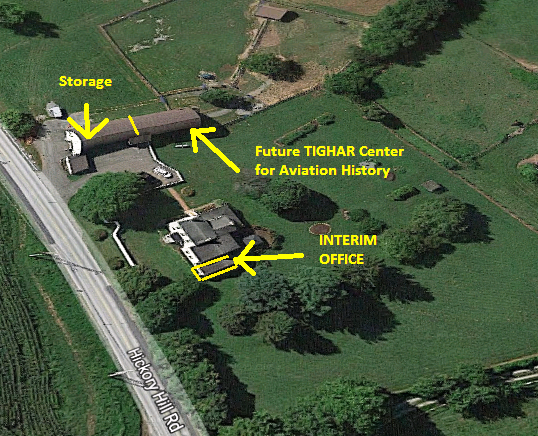 headquarters has tremendous potential for development as a center for aviation
historical research and education." Except:
headquarters has tremendous potential for development as a center for aviation
historical research and education." Except:
- Gillespie said he and Thrasher paid to move
their personal belongings, but not TIGHAR's voluminous materials, which begs the
question, what is TIGHAR's and what is personal, and is it even possible to
separate the two? TIGHAR has been their only known source of income for more
than three decades, so that statement makes little sense.
- "At this new property we hope to create
space and facilities that TIGHAR members can use for meetings, conferences
and research," Gillespie said. In four years, none of
that has happened, except for an initial pay-to-attend open house
attended by a few dozen TIGHAR members.
- Since there is no research center, although the
property came with a newer barn that could readily be remodeled, TIGHAR is still confined to
one room of the house, just as in Delaware. Visitors can presumably appear and get a tour of
that (although no office hours are posted on TIGHAR's website and there is no
identifying sign
outside the house), but most of the artifacts that TIGHAR has brought back from Nikumaroro are
kept in a tiny upstairs room
and away from ready public view.
- Without a research center - or even
current plans for one - and
limited access for the public, people might wonder
how TIGHAR is able to meet its educational mission, which is one reason it got
tax-exempt status in the first place. And what happens to all the
Earhart-related materials if the research center plans fall through?
- In four years, no publicly announced or
regularly-scheduled events, lectures, presentations, etc., regarding
aviation history - or anything else - have been held at Lochaber Farm
according to a review of publicly-available records and TIGHAR's website and Facebook
pages. Which
again raises the question of what, exactly, TIGHAR is doing to accomplish
its mission in order to retain its tax-exempt status.
There has also been occasional discussion
on TIGHAR's forums about Gillespie's salary, which is
now consistently six figures. Over the past eight years alone, some $1.48 million in TIGHAR
donations have been paid directly to Gillespie and Thrasher as salary and
benefits.
In 2015 (the most recent tax year
available), Gillespie received a salary of $171,297; that same year, TIGHAR posted a net loss of $40,086.
Also according to TIGHAR's initial 2015 IRS tax form, Gillespie spent 80 hours a week on
TIGHAR business and activities. That is more than 11 hours a day, seven
days a week. Readers are left to evaluate the credibility
of that statement. It must have given someone pause, because the 2015 form
was revised several times - it now shows him devoting only 60 hours a week to TIGHAR.
While the amount of time Gillespie spends on TIGHAR business may be plausible,
the way his salary is determined is questionable, at best. According to depositions
from a federal fraud lawsuit filed against TIGHAR in 2013, Gillespie said, "we (he and Thrasher) decide
what TIGHAR can afford to pay us" by presenting their board of directors with a
dollar figure - the board (largely handpicked by Gillespie) merely approves it. This is
in sharp contrast to generally-accepted good governance practices for non-profits.
Under Gillespie's leadership, the organization
spent more than $4.36 million in the five-year period ending in 2015, for everything
from his salary to operating expenses to projects - averaging more than $72,000 per
month. Gillespie has consistently stressed that
"expeditions are expensive" (I'll grant him that) and almost as often
has stated that "securing adequate operating expenses" for TIGHAR is
paramount.
Which apparently, to him, is very different from the $1.14 million
spent over the same time period on his self-determined salary
and the rent he charges TIGHAR.
TIGHAR's expenses from 2001-2015 total more than $7.67 million, compared to revenues of just $7.49
million. Gillespie's statement in 2013 that "TIGHAR is
one of the most efficient, cost-effective, low-overhead, most bang-for-the-buck
nonprofits you'll ever see" must be balanced against the fact that his salary
and TIGHAR's rent are more than 26 percent of the organization's
total expenses over just the last five years. Although the board suggested to
Gillespie in 2015 that more information on how TIGHAR operates and where the
money goes needed to be added to the website, two years later, nothing has been
done. TIGHAR has never issued an annual report with a financials section either, to my knowledge, another
thing non-profits at this kind of spending level typically do.
The multiple expeditions to Nikumaroro have been
largely financed by a few high-dollar donors for each one, selling media
rights for television specials, and, to a limited extent, by TIGHAR's
members. That changed with Nikumaroro IX, as noted above. With repeated funding
pitches rejected, it appeared that the Earhart
"faucet of fame" had been twisted shut, so Gillespie adopted a new
method.
Saying that TIGHAR needed to raise money quickly so it
could continue funding the quest for big-dollar expedition funders, Gillespie announced the
"$20,000 in a month" campaigns. In September 2016, and again in January
2017, he challenged TIGHAR members to raise $20,000 in 30 days. The membership
responded, raising more than $49,353 (Gillespie never released a final total).
Shortly after the January campaign, the
Nikumaroro IX
expedition was again drastically scaled down. The
estimated $250,000 cost was not explained in detail, although it is worth
noting that the cheapest berths on the trip organized by another group that was already going
to Nikumaroro were
$8,995 each and TIGHAR members had raised enough money to send at least
five people with the "$20,000 in a month" campaigns. No final accounting for
how the money raised in the "$20,000 in a month" campaigns was spent was ever given.
In his only detailed response about the 2017 expedition, after being
pointedly asked by a longtime TIGHAR member for specifics, Gillespie
said in the discussion forums on March 24, 2017, "Between now and June when the Betchart cruise departs, we need to raise
at least $45,000 just to meet TIGHAR's regular operating expenses."
Assuming 98 days, Gillespie is stating that for that time period
TIGHAR cost almost $460
per day to run. An astonishing amount for a two-person, mom-and-pop,
single-issue non-profit.
All of which
might lead a reasonable person to conclude that these fund-raising campaigns had
little to do
with finding Amelia and everything to do with "operating expenses."
What Happens If You
Disagree with TIGHAR?
Disagreeing with Gillespie on any topic generally leads to one result: You are silenced by being banned from all TIGHAR discussion forums (or so heavily moderated
that you might as well be banned); by having anything you post to TIGHAR's Facebook page deleted, or you are banned outright from posting there as
well. Gillespie's blog is similarly off limits.
 While Gillespie says its members "are TIGHAR's
lifeblood," his public actions and statements make it clear that any
member who deviates from the TIGHAR party line can look forward to biting
sarcasm, minute criticism, or similar intolerance.
While Gillespie says its members "are TIGHAR's
lifeblood," his public actions and statements make it clear that any
member who deviates from the TIGHAR party line can look forward to biting
sarcasm, minute criticism, or similar intolerance.
Gillespie
seems to believe that there is one right answer to every question, he is a very smart
guy (I'll agree with that) and he is able to find that one right answer. Everyone else had better fall in line with his thinking.
Members have few avenues for disagreeing. One option for members to voice their questions or concerns
would be an annual meeting, which many non-profits have and which is allowed for
in TIGHAR's bylaws. Nothing like that has been held in the past two decades -
Gillespie says, "The practicalities
just don't work for TIGHAR." Since there is no contact information for
TIGHAR's board members listed anywhere, that avenue of communication is closed
off as well.
Gillespie applies an extremely heavy hand to any
member (or Facebook commenter) who questions
anything about how he operates, TIGHAR's various projects, his salary and/or
lifestyle, his version of the Earhart narrative, etc, which includes belittling in public
people who even remotely
disagree with him. This includes mass bannings from the discussion forums and
converting the formerly free and public forums to paid, members-only forums in
which posts have dwindled to almost nothing. In short, anyone who disagrees with
Gillespie
is wrong, too dumb to understand, deserves no voice, etc.
Gillespie once told me
that groups that strongly disagree with TIGHAR, its methods and positions, or
him personally, qualify as hate groups and deserve to be silenced.
Really?
And despite his self-avowed "thick skin" and stating that he
ignores all critics, Gillespie is known to spend considerable time some days
perusing websites or discussion forums that disagree with TIGHAR in general and
him in particular. Which might cause TIGHAR members to wonder, at his
documented salary of almost $55 a hour (in 2015), is that an appropriate use of the time that they are
helping to pay for?
Two Bottom Lines
What Happened to Amelia Earhart and Fred Noonan?
I don't know where Amelia and Fred are. Neither does TIGHAR.
Despite
decades of doing what Gillespie calls scientific research, no matter how high a pile of it, or
how weighty a self-labeled "preponderance of evidence" he assembles,
little of it puts us closer to finally resolving the
mystery. That may only happen when TIGHAR's "research" is subjected to outside, third-party
review by individuals unaffiliated with TIGHAR who are qualified to do so - something
Gillespie is reluctant to pursue.
What About TIGHAR?
Gillespie's assertions are unverified
opinions - not science -
and are designed to keep the donations coming in. No other simple, reasonable explanation fits
the
available facts.
Everyone is free to support whichever
causes they want to. I am merely suggesting, following their own analysis of
all the available facts, that
potential donors to TIGHAR be fully aware of its record of repeated
failures, broken promises, and hard-to-explain and/or justify expenses.
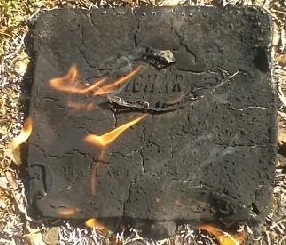
Full Disclosure
- I was a "loyal TIGHAR," as Gillespie calls them, from 1998 - 2016. I joined after
finding a 1992 Life magazine with the now-infamous "We've solved the
Earhart mystery!" story about Nikumaroro expeditions to date. Throughout my
18-year membership I vigorously participated in the TIGHAR discussion forums (more than
1,050 posts); attended an aviation archaeology
field school and an Earhart conference; participated in the Dayton trip and
formulation of the report on The Patch; bought many T-shirts,
posters, coffee mugs, etc.; flew to Wyoming to support TIGHAR against the federal
fraud lawsuit filed by
millionaire (and former TIGHAR donor) Tim Mellon; and along the way donated in
excess of $50,000 to TIGHAR or directly to Gillespie for various trips, research
reports, technical analyses, equipment, etc.
I now consider the majority of that money wasted
on an operation that has repeatedly failed because of unsupported assumptions; poor planning;
inadequate, incomplete and undirected research; and consistently improper execution.
Gillespie is, at the end of the day, an extraordinarily
good showman - and that's all.
Monty Fowler, December 2017
ALL PHOTOS AND TEXT © COPYRIGHT 2016-2017 BY THE
AUTHOR. SOME ILLUSTRATIONS UTILIZED UNDER UNITED STATES COPYRIGHT "FAIR USE"
IN TITLES 17 AND 107 USC. ALL RIGHTS RESERVED. REPRODUCTION,
RETRIEVAL OR STORAGE BY ANY METHOD FOR ANY PURPOSE IS PROHIBITED BY THAT SCUMBAG
LAWYER IN CHARLESTON, OR ANY LAWYER FOR THAT MATTER. YEAH, YOU, BILL
CARTER.
Return to the Main Index
Page
This page was last updated Dec. 25,
2017

 Francois Coli, who took off from an airfield near Paris in May 1927 in
the bid to be the first to cross the Atlantic Ocean from Paris to New York non-stop. They never
made it. A few weeks later, American Charles Lindbergh crossed the Atlantic, landed in Paris and
made aviation history.
Searches turned up no trace of the Frenchmen.
Francois Coli, who took off from an airfield near Paris in May 1927 in
the bid to be the first to cross the Atlantic Ocean from Paris to New York non-stop. They never
made it. A few weeks later, American Charles Lindbergh crossed the Atlantic, landed in Paris and
made aviation history.
Searches turned up no trace of the Frenchmen.

 Persistent rumors said that at the end of World
War II, German forces dynamited underground hangers full of intact
Luftwaffe aircraft, to hide them from the advancing Allies. A "treasure trove" of
aviation history, Gillespie wondered? TIGHAR investigated
what it called "the most
promising rumors" via archival research and on-site inspections. Despite two decades of
on-again, off-again searching, TIGHAR found nothing. The project was deactivated
in 2008;
final costs have never been released publicly.
Persistent rumors said that at the end of World
War II, German forces dynamited underground hangers full of intact
Luftwaffe aircraft, to hide them from the advancing Allies. A "treasure trove" of
aviation history, Gillespie wondered? TIGHAR investigated
what it called "the most
promising rumors" via archival research and on-site inspections. Despite two decades of
on-again, off-again searching, TIGHAR found nothing. The project was deactivated
in 2008;
final costs have never been released publicly.  By far TIGHAR's most well-known/publicized
and highest-profile effort. Amelia Earhart,
the world-famous aviatrix, and her navigator, Fred Noonan, vanished without a
trace in the Pacific Ocean in 1937 while trying to fly around the world. TIGHAR
entered the decades-old controversy of what happened to them in 1988 with the launching
of the Earhart
Project. TIGHAR has conducted 12 expeditions to date to Nikumaroro, a remote island in the central Pacific Ocean, where Gillespie
hypothesizes that Earhart and Noonan successfully landed and eventually died.
By far TIGHAR's most well-known/publicized
and highest-profile effort. Amelia Earhart,
the world-famous aviatrix, and her navigator, Fred Noonan, vanished without a
trace in the Pacific Ocean in 1937 while trying to fly around the world. TIGHAR
entered the decades-old controversy of what happened to them in 1988 with the launching
of the Earhart
Project. TIGHAR has conducted 12 expeditions to date to Nikumaroro, a remote island in the central Pacific Ocean, where Gillespie
hypothesizes that Earhart and Noonan successfully landed and eventually died.  In 1942, two US Navy TBD-1 Devastator
torpedo bombers ditched in the lagoon of Jaluit Atoll in the Pacific Ocean
after being hit by antiaircraft fire during a raid on the Japanese-held
island. TIGHAR calls the TBD one of the most significant aircraft in the history
of naval aviation (sound familiar?), and states that since no example of the
Devastator survives in any museum, recovering one would be an extremely valuable
undertaking to the aviation historical community (sound familiar?). TIGHAR launched a project in 2004 to
survey and/or recover one or both of the wrecks.
In 1942, two US Navy TBD-1 Devastator
torpedo bombers ditched in the lagoon of Jaluit Atoll in the Pacific Ocean
after being hit by antiaircraft fire during a raid on the Japanese-held
island. TIGHAR calls the TBD one of the most significant aircraft in the history
of naval aviation (sound familiar?), and states that since no example of the
Devastator survives in any museum, recovering one would be an extremely valuable
undertaking to the aviation historical community (sound familiar?). TIGHAR launched a project in 2004 to
survey and/or recover one or both of the wrecks. nearby castle,
and calls it one of the most significant WWII-related archaeological
discoveries in recent history: "Recognizing the Lightning’s historical significance
as the oldest surviving Eighth Air Force combat veteran, and its potential as an
object of study in corrosion research, TIGHAR has made a commitment to champion
the aircraft’s recovery and preservation." Again, does this verbiage sound familiar?
And, again, no other aviation-related entity has made a
similar determination.
nearby castle,
and calls it one of the most significant WWII-related archaeological
discoveries in recent history: "Recognizing the Lightning’s historical significance
as the oldest surviving Eighth Air Force combat veteran, and its potential as an
object of study in corrosion research, TIGHAR has made a commitment to champion
the aircraft’s recovery and preservation." Again, does this verbiage sound familiar?
And, again, no other aviation-related entity has made a
similar determination.  of the Norwich City,
a compilation of photos showing the gradual disintegration of a ship that ran
aground at Nikumaroro in 1929. The photos are available on the
internet. Is stringing them together in one web document a
"research bulletin," or simply a way to make something look and sound like more than
what it really is? Would it be more accurate to call these "promotional pieces"
for TIGHAR's theory?
of the Norwich City,
a compilation of photos showing the gradual disintegration of a ship that ran
aground at Nikumaroro in 1929. The photos are available on the
internet. Is stringing them together in one web document a
"research bulletin," or simply a way to make something look and sound like more than
what it really is? Would it be more accurate to call these "promotional pieces"
for TIGHAR's theory?
 TIGHAR could keep all of the profits from media
rights. Fair enough. Anyone who donated at least $49 to the production through
the Your Name Up In Lights campaign would receive a credit at the video's end as
a way of thanks. An unknown number of people donated (TIGHAR never released
specifics). All well and good.
TIGHAR could keep all of the profits from media
rights. Fair enough. Anyone who donated at least $49 to the production through
the Your Name Up In Lights campaign would receive a credit at the video's end as
a way of thanks. An unknown number of people donated (TIGHAR never released
specifics). All well and good. evidence" for
how Earhart and Noonan ended up on Nikumaroro. It was partly funded by TIGHAR members through
the so-called Literary Guild. For a donation of at least $100, contributors would
get a signed copy of the book when it was published. Ninety-three
members joined the Literary Guild, and Finding
Amelia was published.
evidence" for
how Earhart and Noonan ended up on Nikumaroro. It was partly funded by TIGHAR members through
the so-called Literary Guild. For a donation of at least $100, contributors would
get a signed copy of the book when it was published. Ninety-three
members joined the Literary Guild, and Finding
Amelia was published. headquarters has tremendous potential for development as a center for aviation
historical research and education." Except:
headquarters has tremendous potential for development as a center for aviation
historical research and education." Except: While Gillespie says its members "are TIGHAR's
lifeblood," his public actions and statements make it clear that any
member who deviates from the TIGHAR party line can look forward to biting
sarcasm, minute criticism, or similar intolerance.
While Gillespie says its members "are TIGHAR's
lifeblood," his public actions and statements make it clear that any
member who deviates from the TIGHAR party line can look forward to biting
sarcasm, minute criticism, or similar intolerance. 
